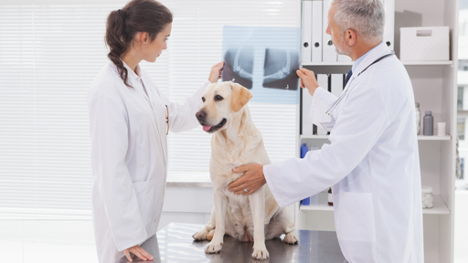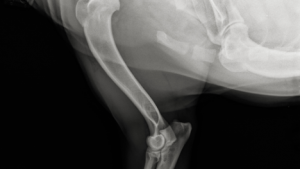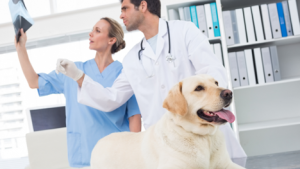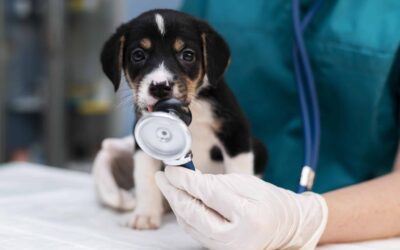How Much Is an X-ray for Dogs? Stomach, Chest & More

Updated November 16, 2025
We give our dogs the best care possible because they’re part of our family. Despite all we do to protect them, sometimes pets get hurt, fall ill, or eat something they shouldn’t, and these moments can be frightening for any pet parent. When this happens, they may need an X-ray of their stomach, chest, or other areas to diagnose what’s wrong and guide treatment.
X-rays are a common diagnostic imaging procedure in veterinary medicine, helping veterinarians assess your dog’s health and diagnose various conditions so your furry friend can get the care they need.
This article shares age-specific guidelines for dog X-rays, the average costs you can expect, and how your dog’s health and medical history could impact X-ray frequency.
Understanding Pet X-rays
X-rays are a form of diagnostic imaging that uses electromagnetic radiation to create detailed images of your dog’s internal structures, including bones, organs, and tissues. Veterinarians order a pet X-ray when they want to diagnose or rule out various conditions that might be affecting your furry friend:
Broken Bones
If your pet is limping or showing signs of pain, a vet will examine the area to check for broken bones that need treatment. X-ray images provide detailed views of your dog’s bone structure and are crucial for diagnosing fractures and determining the most effective course of action.
Blockage In The Intestines
When dogs swallow something they shouldn’t—such as toys, socks, or other household items—it may cause a potentially dangerous intestinal blockage. A stomach X-ray can reveal the object’s exact location and help your vet decide if surgery is needed.
Bladder Stones
Dogs get bladder, gallbladder, or kidney stones just like humans, and these can be extremely painful. X-rays show their location and whether they are causing blockages that require immediate intervention.
Tumors
Not all tumors are visible on an X-ray, but it’s a good first step in diagnosis because it’s less expensive than a CT scan. Standard X-rays and basic diagnostic X-rays are often the first step in identifying abnormalities before more advanced imaging is considered.
Dental Problems
Most vets recommend a yearly dental X-ray to spot gum or tooth problems before they become serious. Dogs are usually sedated during dental X-rays to ensure clear images and keep them comfortable.
Pregnancy
Vets X-ray a pregnant dog to check the puppies’ health and development. The images also determine how many puppies a female dog carries, their position, and whether the mother can safely deliver them through the birth canal without complications.
Hip Concerns
Hip dysplasia is diagnosed with an X-ray that shows the joint structure. These images help a vet decide the best treatment plan for your dog to manage pain and maintain mobility.
Heart or Lung Problems
Vets perform X-rays if your dog has breathing problems or shows signs of respiratory distress. A dog’s chest X-ray can reveal not only the lungs but also blood vessels and soft tissues, helping to diagnose a range of conditions such as pneumonia, bronchitis, a fungal infection, or a mass.
While X-rays are excellent for visualizing your dog’s bones and some soft tissues, they may not clearly show all soft tissue organs, and other diagnostic imaging techniques, such as ultrasound, MRI, or CT scans, may be needed for a comprehensive assessment of your beloved pet’s condition.
The X-ray procedure involves positioning your dog carefully and minimizing movement to ensure clear images that provide accurate information. Basic diagnostic X-rays are a fundamental, first-line tool in veterinary medicine, and understanding the process helps pet owners know what to expect and feel more at ease.
How Often Should You Get an X-ray for Your Dog?
Age-Related X-rays
Veterinarians use X-rays to check for your dog’s potential health problems, but they can also be used preventatively during a routine senior dog wellness check if necessary, due to your dog’s specific health history or conditions.
Puppies
Pregnant dogs are X-rayed to determine the exact number of puppies she’s carrying, the size of the puppies, and their location within the womb. X-rays also help determine the age of a puppy, which can be a valuable piece of information. A vet may recommend an X-ray if a puppy is a rescue dog and there’s uncertainty about their age for proper care planning.
Young Adults
Adult dogs should receive dental X-rays yearly to maintain oral health and prevent disease. A dog may have dental disease if it has broken or missing teeth, inflamed or swollen gums, or persistent bad breath. An X-ray helps a vet understand the depth of the problem and create an effective treatment plan.
Senior Dogs
X-rays assess an older dog’s overall health and are crucial for early detection of age-related conditions. They detect early-stage cancers, tumors, heart or lung issues, hip or joint problems, or osteoporosis, which are common in senior dogs who need extra monitoring. A vet can diagnose arthritis in older dogs with an X-ray, as the image shows swelling and any changes to your dog’s bones that indicate joint deterioration.
Breed-Specific Considerations
Your dog’s breed and size determine how often they need to be X-rayed during their lifetime. X-rays are a good preventive measure, especially for certain breeds prone to specific health issues. Larger dogs and smaller dogs may have different X-ray needs and associated costs, as size can affect the amount of sedation required and the likelihood of specific health issues.
Large and Giant Breeds
Larger dog breeds are prone to elbow and hip dysplasia, as well as other joint problems, which can significantly impact their mobility and comfort. They’re also prone to arthritis as they age due to the extra stress on their joints. A veterinarian may use X-rays as a preventive measure for early diagnosis and treatment of these problems, helping your beloved companion maintain their quality of life.
Small Breeds
Displaced kneecaps are common for smaller breeds and can cause pain and mobility issues. X-rays help detect displacement early, allowing treatment to begin before the problem worsens. Small breeds commonly affected with displaced kneecaps include:
- Miniature poodles
- Chihuahuas
- Boston terriers
- Pomeranians
- Yorkshire terriers
Health Condition and History
A dog’s health condition or medical history impacts how often a dog needs X-rays. Certain chronic conditions require closer monitoring with regular X-rays and tests. Common ailments that require regular X-rays include a history of
- Hip dysplasia or joint problems: When a dog has hip or joint problems, regular X-rays are taken to monitor the progression of the problem and adjust treatment as needed.
- Dental concerns:When a dog has missing teeth, bad breath, or broken teeth, it may indicate dental disease that needs attention. Yearly X-rays can diagnose problems and help vets treat the issue before it affects your dog’s overall health.
- Cancer: Once your dog is diagnosed with cancer, they’ll receive regular X-rays to monitor the disease and evaluate whether treatment is working effectively.
- Tumors: Although some tumors are benign and not immediately dangerous, vets will do regular X-rays to monitor them and ensure they’re not growing or changing in concerning ways.
Regular X-rays are an essential part of a comprehensive approach to your dog’s care, particularly for those with chronic conditions, and should be considered when budgeting and planning for your dog’s ongoing health needs and well-being.

X-ray Frequency for Working and Sporting Dogs
Sport or working dogs get a lot of exercise and require regular monitoring to identify potential problems early, which is essential for their continued performance and comfort. This may include X-rays to detect any early signs of musculoskeletal problems, such as injuries or nerve, muscle, joint, tendon, cartilage, or spinal disc issues that could sideline your active companion.
Factors Affecting Pet X-ray Costs
Several factors affect the cost of a dog X-ray, including your dog’s size, the number of images needed, and the complexity of the injury or condition. X-rays cost more at emergency clinics compared to a regular vet clinic due to the urgent and specialized services provided when your beloved pet needs immediate care. Factors that contribute to the cost of an X-ray include whether your dog needs to be sedated for safety and image clarity, the number of views the vet must take to obtain a complete picture, and the area of the body being X-rayed.
Most dogs require some sedation during the X-ray procedure to ensure clear images, especially for your furry friend’s safety and comfort during the process.
On average, a pet X-ray can cost $50 to $400. The typical cost and average costs for dog X-ray expenses can vary widely depending on several factors, including your dog’s size, breed, medical history, and the complexity of the medical issues being investigated. Pet insurance plans can help pet parents manage these X-ray bills by covering diagnostic tests, such as X-rays for injuries and illnesses, providing peace of mind. Of course, emergencies such as a dog swallowing a foreign object will cost more than a routine screening X-ray.
Cost Breakdown of Pet X-rays
X-ray costs will vary depending on where you live and what type of X-ray your dog needs. These are the average cost breakdowns for pet X-rays.
| Type of X-ray or Treatment Before X-ray | Cost of X-ray |
| Sedation: The dog may need this to help calm them down and guarantee a clearer image | $50 to $220 |
| Chest X-ray-Looking for pneumonia, tumors, or asthma | $150 to $250 |
| Stomach X-ray | $150 to $250 |
| Broken bone X-ray | $150 to $400 |
| Dental X-ray | $50 to $90 |
| Lung X-ray | $150 to $250 |
| Emergency X-rays | $200 to $400 |
Consultation fees will also add to the cost of X-rays.
What Is the Cost of a Dog Chest X-ray?
A dog’s chest X-ray is used to examine the thoracic region for issues such as heart or lung problems, which can influence the cost based on the complexity of the condition. The average price of a dog chest X-ray ranges from $75 to $250, depending on your location and the specific area being X-rayed.
Is a Normal Dog Stomach X-ray Different from an Abnormal One?
An abdominal X-ray involves examining organs such as the small and large intestines, stomach, spleen, liver, and diaphragm to assess your dog’s digestive system health.
While X-rays can show the outline of these organs, they may not provide detailed images of soft tissue structures in all cases. For more precise visualization of soft tissue when needed, your veterinarian may recommend advanced imaging techniques such as ultrasound, MRI, or CT scans.
How Much Does a Dog Leg X-ray Typically Cost?
The average dog leg X-ray costs $100 to $425, depending on the location and the need for sedation to keep the dog still for the imaging.
What Does a Normal Dog Lung X-ray Look Like?
Your dog’s respiratory system comprises the small and large airways, as well as the lungs, which enable them to breathe comfortably. A dog breathes air through their nose and mouth, and the air travels through their trachea into the right or left bronchi, then into smaller areas called bronchioles in their lungs. Small sacs called alveoli are at the end of the bronchioles. Your dog’s respiratory system delivers oxygen into the blood throughout the body and removes carbon dioxide from the blood. Disease or infection can disrupt this oxygen flow, leading to serious illnesses that require immediate attention.
A lung X-ray can also reveal the condition of blood vessels in the chest, which is important for diagnosing certain heart and circulatory diseases.
How Can Pet Insurance Help?
Because X-rays and other medical costs can add up quickly, especially with chronic conditions, pet insurance helps ease the burden of these costs and gives you peace of mind. Odie Pet Insurance offsets the cost of injuries, illness, and preventative care for dogs so you can focus on your furry friend’s recovery. Pet insurance can also help cover unexpected medical costs for your fur baby, giving you confidence as a pet parent that you can afford the care they need.
Odie Pet Insurance covers X-rays in its comprehensive plan, which means less financial stress when your pet needs diagnostic imaging. If your pet requires a diagnostic X-ray, this portion of the cost, or all of the costs, may be covered, depending on your plan. One caveat is that Odie doesn’t cover pregnancy X-rays.
Pet insurance gives you control over your budget without being burdened by unexpected vet bills. Odie Pet Insurance makes your pet’s medical care manageable.
What about the claims process for pet insurance?
When looking into pet insurance, understand the claims and payment process.
Reimbursement
This method is the most common for pet insurance companies. You pay out of pocket for the veterinarian bill, and then the insurance company reimburses you for what’s covered under the insurance plan. The steps look like this.
- You pay the vet bill after your dog’s visit.
- You fill out the pet insurance claim form.
- Submit the claim form and other required documentation to the insurer.
- After the claim is approved, you will be reimbursed for eligible expenses.
What Does Odie Pet Insurance Cover?
Pet insurance covers various veterinary expenses, providing financial protection and peace of mind for pet owners who want the best for their furry friends. Pet insurance often covers diagnostic tests such as X-rays, blood work, and other procedures needed to diagnose your pet’s health issues. Here are the details of the coverage options we offer:
Illness & Injury Plan
The Illness & Injury Plan is an all-inclusive insurance plan designed to cover a wide range of medical needs for your pet. This plan includes comprehensive coverage for various illnesses, injuries, and veterinary services. Some of the covered items include:
- Veterinary exams and consultations
- Diagnostics (e.g., X-rays, lab tests)
- Prescribed medications
- Surgeries and hospitalization
- Rehabilitation, acupuncture, or chiropractic treatments
- Medically necessary supplies
- Euthanasia and cremation
The Wellness Plan
The Wellness Plan is a monthly membership that focuses on preventive care and covers routine veterinary services.
- Provides reimbursements for routine care items such as wellness visits (exams and vaccines), testing and parasite prevention, dental cleanings and at-home dental care, vitamins, supplements, and more
- Through Odie’s partnership with Petivity, a leader in smart pet products and proactive care, Wellness Plan members can also receive reimbursements for Petivity devices and health kits, as well as eligible Purina food and supplements.
- Total reimbursement up to $700 per year.
FAQs:
How much does a dog X-ray cost, and what affects the price?
Average cost: $100-$250 per X-ray. Factors affecting price include the dog’s size (larger dogs require more sedation), the location being X-rayed, the need for sedation or anesthesia, the type of clinic (emergency vs. regular), and geographic location.
When does my dog need an X-ray?
X-rays detect broken bones/fractures, swallowed foreign objects, internal injuries, organ health issues, tumors/cancer, dental problems, and chronic conditions (hip dysplasia, arthritis). Frequency depends on breed, age, and health. Larger breeds, which are prone to hip dysplasia/joint problems, require more frequent preventive X-rays. Smaller breeds with displaced kneecaps need regular monitoring. Seniors benefit from periodic X-rays to detect cancers, heart/lung issues, and osteoporosis.
What happens during an X-ray, and is sedation required?
The dog is positioned on the table between the X-ray tube and the sensor. It takes approximately 10 minutes and may require repositioning to achieve different angles. Digital images are available immediately. Sedation is NOT always needed—only if the dog is anxious, in pain, unable to remain still, or requiring X-rays of the spine/skull/teeth, needing muscle relaxation.
Are X-rays safe, and what can they detect?
Yes, generally safe. Radiation exposure is minimal and negligible compared to diagnostic benefits. X-rays are typically used only occasionally. Can detect: bone fractures, foreign objects, organ size/shape issues, fluid in lungs, heart size abnormalities, bladder stones, certain types of tumors/cancers, and arthritis/joint swelling.
Does Odie Pet Insurance cover X-rays?
Yes. Odie’s comprehensive Accident & Illness plan covers diagnostic X-rays (excluding those related to pregnancy) and offers flexible options for reimbursement rates, deductibles, and payout limits. Wellness Plan focuses on preventive care (up to $700/year reimbursement), but diagnostic X-rays fall under the Accident & Illness plan.






